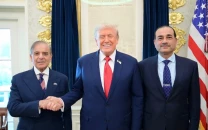Pakistan biggest importer of Chinese arms: report
Pakistan is considered linchpin of nation's South Asia policy

Chinese People's Liberation Army (PLA) soldiers take part in the Pakistan-China anti-terrorist drill as they wrap up their two-week military exercise in Jhelum on November 24, 2011. PHOTO: AFP
Since the beginning of the 21st century, China has been a key supplier of major conventional weapons to South Asian countries especially Pakistan and Bangladesh. Sales to both amount for over half of total Chinese total arms sales over 2000-14. Bangladesh amounts for 11 per cent of the sales, making China the world's third-largest arms exporter.
Probably the most notable Chinese sale to South Asia was the sale of JF-17 fighters to Pakistan followed by an agreement to build the jets in Pakistan under a joint venture: the Pakistan Aeronautical Complex/Chengdu Aerospace Corporation.
China has continued to provide considerable military assistance to Pakistan including helping develop the country's nuclear program. During the mid-1970s Beijing covertly assisted Islamabad's nuclear ambitions to counter New Delhi, according to the document. This reportedly included the design of a nuclear weapon and fissile material.
Pakistan turns to China for high-end weapons: report
"In 1988, China agreed to supply and train Pakistanis in the operation of the M-11 solid-fuel rocket, with a 185-mile range and carrying a 1,100-pound warhead. The missiles arrived in 1995. In subsequent decades, China has sold Pakistan hundreds of jet fighters and signed agreements to sell frigates and submarines to Pakistan," the report read.
Military exercises
Besides arms sales, China has also held military exercises with South Asian countries - more than a quarter of their exercises between 2002 and 2014 were held with South Asian countries. Many of these exercises focused on counter-terrorism operations with Pakistan, India and Sri Lanka as major partners.
Of the 24 conducted over 2002-14, two-thirds (16) were held with Pakistan. While the relationship with Pakistan is "quasi-alliance" in nature, China also held five exercises with India. This is indicative of Beijing not wanting "close ties with Islamabad to come at the expense of a confrontational relationship with New Delhi."
Select Chinese exercises in Pakistan
[jtrt_tables id="1828568"]
China-Pakistan 'pivotal' relationship
China continues its Pivotal Regional Partnership (PRP) with Pakistan in South Asia. The relationship has acquired greater importance than a simple check on India of late. According to the document, close ties with Pakistan, "the linchpin of China's South Asia policy", are based on three factors: ensuring China's internal stability, balance against India and defending China's burgeoning economic interests.
Islamabad will continue to be an important partner for Beijing because of the conflictual future of the region. "Pakistan’s political stability and national unity is crucial to China, not only to ensure that Islamabad remains a counterweight to India but also because, as an Islamic state and nuclear power its instability or disintegration would send shockwaves cascading far and wide."
Pakistan's relationship with China was capped in April 2015 with the inking of agreements between the two countries promising investments of up to $46 billion and the construction of a China Pakistan Economic Corridor (CPEC) of roads, rail lines, and pipelines. The corridor is to run from Gwadar in Pakistan through Lahore and Islamabad to Xinjiang Uighur Autonomous Region in China.
Beijing is also concerned about energy security and CPEC is an effort to diversify its petroleum import routes. China, has been a net importer of oil since 1993, and the overwhelming majority of petroleum arrives in the PRC via Southeast Asia. "To improve security in the Indian Ocean, China has adopted what one US consulting firm dubbed a 'String of Pearls' strategy working to establish a network of port facilities in countries around the Indian Ocean region." Developing Gwadar, reportedly leased by a Chinese company, constitutes a key element.
'Pak-China military drills foster regional peace'
Strong China-India economic ties relations, however, continue to hold steady. India is China’s largest trading partner in the region and is both, its largest source of imports and export destination.
"China’s two-way trade with India now dwarfs that with Pakistan. Between 2000 and 2013, Sino-Indian two-way trade jumped 22-fold to $65 billion. In contrast, Sino-Pakistani two-way trade has increased very slowly over the same period, to reach a modest $14 billion in 2013."
Soft power
Beyond economic and military hard power, China has also expanded its soft power reach. It has established eight Confucius Institutes across six countries in South Asia. India and Pakistan have two each. Afghanistan, Bangladesh, Nepal, and Sri Lanka each boast a single.


















COMMENTS
Comments are moderated and generally will be posted if they are on-topic and not abusive.
For more information, please see our Comments FAQ